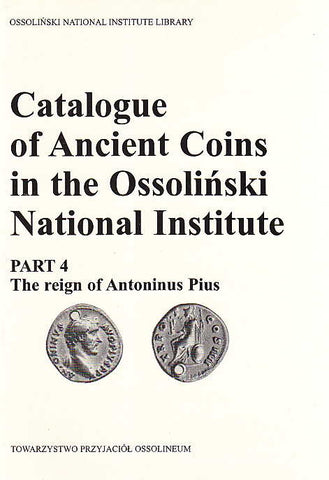Catalogue of Ancient Coins in the Ossolinski National Institute. Part 4: The reign of Antoninus Pius
20,00 $
ISBN: 83-77095-020-5
Description: 89 pages, 558 b&w photographs
Condition: very good
Weight: 278g.
Catalogue of Ancient Coins in the Ossolinski National Institute. Part 4: The reign of Antoninus Pius, Ossolineum 1989
Abbreviations
Catalogue
Index of types
Index of legends
Greek legends
Concordance
Plates
The fourth volume of the catalogue of ancient coins in the collections of the Ossolinski National Institute registers the coins of Antoninus Pius and his family: his wife Faustina the Elder, his son Marcus Aurelius, and his daughter Faustina the Younger.
The reign of Antoninus Pius (138-161) and his successor Marcus Aurelius (161-180) is a period-initiated by Trajan and Hadrian of political stabilization and economic growth of the Roman Empire which in the 2nd century reaches the hieght oh its grandeur. The principles of that reign, called the golden age or the age of the Antonines. arc best characterized by the personification of Aequitas, Felicitas, and Fides that were often placed on the issues of silver and bronze coins.
The intense political and economic expansion in the 2nd century brought with it ihe widening of Rome's borders and influences northwards and to the territories beyond the Danube, reaching as far as the present Slovakia. The contacts with the peoples inhabiting those areas resulted in an influx of Roman currency beyond the limes of the Roman Empire, including the territory of the old and contemporary Poland. This process is reflected by numerous hoards and lesser finds that constitute the major source of 2nd century coins, especially those minted during the reign of Antoninus Pius and Marcus Aurelius. That explains why in many Polish collections the coins among which there is a preponderance of silver denarii-date from the times of those emperors and constitute the most numerous group.
The structure of the Ossolineum collection is a typical illustration of this phenomenon -the coins registered in the present volume, 558 in all. from the biggest group in the collection of Roman coins.
An important characteristic of the mintage of that age, initiated by Vespasian, was the concentration in Rome of the issues of denarii, a currency of nationwide character, whose metallic value did not undergo significant fluctuations during the whole of the 2nd century. Of the provincial mints only that in Alexandria functioned, issuing numerous billon tetradrachms and bronzes indispensable for the economy of Roman Egypt. The monopoly of Rome's mint contributed to the achievement of a high standard of the technique of coinage, regular and numerous issues and long scries of types. The official, typical titula-turc stabilizes at that time making it possible to date the coins on the basis of offices held: consulate, the number of years of tribuneship, and imperial acclamations.
Among the most valuable coins presented in vol. 4 arc those from the Wroclaw hoard whose parts going back to the reign of Trajan and Hadrian were presented in vol. 3'. Equally valuable is the aureus of Antoninus Pius from 146-161. dug out at the village of Chclmcc in the Bydgoszcz district and purchased for the collections in 1994 (No cat. 68). As in the previous volumes, fakes arc included as arc, for the first time, medallions-con-torniates whose date and place of origin are unknown.











